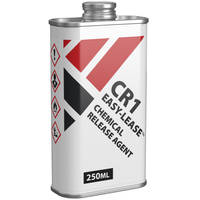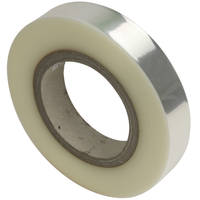Heb je hulp of advies nodig?+44 (0)1782 454499
PRODUCTEN GEBRUIKT IN DIT PROJECT
Hoewel dit niet per se een uitputtende lijst is, werden de volgende gereedschappen en materialen, geleverd door Easy Composites, in dit project gebruikt.
De hoeveelheid die hieronder wordt weergegeven, is de geschatte hoeveelheid die in het project wordt gebruikt, afgerond naar de dichtstbijzijnde beschikbare kitgrootte of hoeveelheid.
VERSTERKINGEN
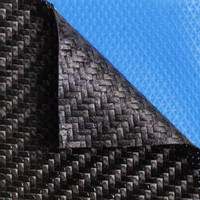
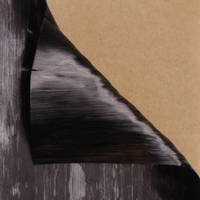
VIDEO HANDLEIDING
Hoe Maak je een Gewikkeld Koolstofvezelbuis
In deze tutorial leer je hoe je een metalen doorn, prepreg koolstofvezel en krimptape gebruikt om een op maat gemaakte koolstofvezelbuis te maken met behulp van het rolwikkelproces.
Het rolwikkelproces wordt gebruikt door composietfabrikanten om buizen van koolstofvezel met hoge sterkte te produceren, hetzij met een onafgewerkt basisuiterlijk of met een cosmetisch afgewerkt uiterlijk. Easy Composites heeft een van de grootste assortimenten gewikkeld koolstofvezelbuizen die online te koop zijn. Soms ontstaat echter de behoefte aan een koolstofvezelbuis met zeer specifieke afmetingen, vezeltype/oriëntatie of uiterlijk.
Als de buis die je wilt maken parallelle zijden of een doorlopende conus heeft, is het mogelijk om het wikkelproces te gebruiken om je eigen koolstofvezelbuis op maat te maken zonder dat je speciale machines nodig hebt, behalve een metalen doorn van de juiste maat en een oven die groot genoeg is om de buis in uit te harden.
Als je in plaats daarvan een koolstofvezelbuis moet maken die niet recht is, zoals een stuur of een complexere buisvormige framestructuur zoals een vorkbeen of fietsframe, bekijk dan onze handleiding over het maken van een koolstofvezelbuis met behulp van een splitmal.
Hieronder worden de materialen en processen uitgelegd die in de tutorial worden gebruikt.
UITSPLITSING TUTORIAL
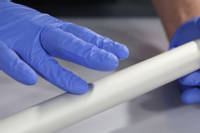
1. Metalen doorn
Het wikkelproces bestaat uit het wikkelen van prepreg koolstofvezel rond een metalen doorn. Het uitgangspunt is dus om een metalen doorn te hebben met de juiste diameter voor het formaat buis dat je wilt maken. Omdat de koolstofvezel rond de buitenkant van de doorn wordt gewikkeld, moet de doorn zelf een buitendiameter hebben die overeenkomt met de binnendiameter van de koolstofvezelbuis die je ermee gaat maken. De buitendiameter van je koolstofvezelbuis wordt bepaald door de hoeveelheid wapening (het aantal lagen) die je om de doorn wikkelt.
In de video gebruiken we een aluminium doorn omdat de hoge thermische uitzettingscoëfficiënt (CTE) van aluminium het zeer geschikt maakt voor het wikkelproces. Staal of andere metalen kunnen worden gebruikt, maar metalen met een hogere CTE maken het proces gemakkelijker.
Als je een taps toelopende koolstofvezelbuis wilt maken, zul je waarschijnlijk een massieve aluminium staaf op een draaibank moeten afdraaien om een taps toelopende doorn te maken.
Als je eenmaal een doorn van de juiste maat hebt, zorg er dan voor dat deze helemaal schoon en zo glad mogelijk is om het extraheren te vergemakkelijken. Vervolgens moet de doorn grondig worden geprepareerd met een chemisch lossingsmiddel bij hoge temperatuur, zoals Easy-Lease.
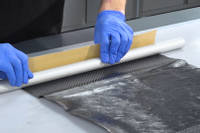
2. Prepreg koolstofvezel
Hoewel het in theorie mogelijk is om alternatieve soorten versterkingen te gebruiken, zoals een droog weefsel dat is bevochtigd met epoxyhars, biedt in de praktijk alleen prepreg koolstofvezel de precisie en het gebruiksgemak die nodig zijn voor het wikkelproces op rollen.
In de tutorial gebruiken we een laag XPREG® XC110 210g geweven prepreg aan de binnenkant van de buis, gevolgd door verschillende lagen XC130 300g unidirectionele prepreg, afgewerkt met een laatste laag XC110 210g geweven prepreg aan de buitenkant van de buis. Omdat het geweven prepreg vezels heeft die georiënteerd zijn in de 0°-as (langs de lengte van de buis) en in de 90°-as (rond de omtrek van de buis) voegen deze lagen wat bekend staat als hoepelsterkte toe aan de buis, waardoor de buis minder kwetsbaar is voor druk- of barstkrachten en splinteren. Het grootste deel van de wapening, in de 0°-as, geeft de buis zijn stijfheid in de lengterichting.
Door de lay-up te wijzigen en meer of minder geweven lagen toe te voegen of door de oriëntatie van de unidirectionele lagen te wijzigen of af te wisselen, kunnen de prestaties van de buis nauwkeurig worden geoptimaliseerd voor het specifieke gebruik. Een buis voor een schroefas zal bijvoorbeeld voornamelijk te maken krijgen met torsiekrachten en dus kunnen de unidirectionele vezels buiten de as worden uitgelijnd, bijvoorbeeld onder een hoek van 45°, specifiek om deze krachten op te vangen.
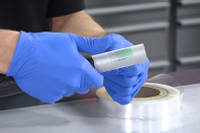
3. Composietkrimptape
Nadat het prepreg koolstof weefsel zo strak mogelijk om de doorn is gewikkeld, wordt de wapening strak omwikkeld met een composiet krimptape om verdere consolidatie te verkrijgen.
Bij het aanbrengen van de krimptape is het belangrijk dat er veel overlap is. Elke wikkel van de tape gaat maar een paar millimeter verder in de buis. Hoewel het tijdrovend is om met de hand te doen, zorgt veel overlap op deze manier voor veel meer verstevigingsdruk wanneer de tape tijdens het uitharden samentrekt.

4. Uitharden in de oven
Naast de doorn is het hebben van een oven om de buis in uit te harden waarschijnlijk de belangrijkste beperkende factor bij het overwegen van het wikkelproces buiten een volledige productieomgeving. In tegenstelling tot andere prepreg processen vereist het wikkelproces echter geen nauwkeurige temperatuurregeling of de vaak benodigde 'ramp and soak' uithardingscycli in meerdere stappen. Het proces vereist ook geen actieve vacuümleiding naar de oven. Daarom zijn de enige vereisten voor een oven om gewikkeld buizen uit te harden een eenvoudige temperatuurregeling en voldoende afmetingen om de buis in te passen. Afhankelijk van de grootte van de buis die je wilt maken, kun je alles gebruiken, van een huishoudoven tot een poedercoatoven.
In de videotutorial gebruiken we onze OV301 precisiecomposieten uithardingsoven. De XPREG XC110 prepreg wordt in de oven geladen op 120°C, vlakke temperatuur, en mag 1 uur 30 minuten uitharden.
DISCUSSIE (34)
Laat het ons weten als je vragen of opmerkingen hebt over deze videotutorial.
Het kan zeker worden gedaan als een natte laag bij kamertemperatuur. Met pre-preg, zoals in de video, kan het zijn dat voor de meeste standaard gepultrudeerde buizen de temperatuur van de uithardingscyclus hoger is dan de hittebestendigheid van de buis, waardoor deze zachter wordt, vervormt of zelfs verbrijzelt tijdens de uithardingscyclus.
Het fabricageproces voor een cardanas zou heel goed kunnen lijken op het proces dat in deze video wordt getoond, hoewel de vezeloriëntatie heel anders zou zijn. Voor toepassingen met een hoog koppel zou je willen dat het grootste deel van de vezel in een spiraal rond de buis loopt (bijvoorbeeld 45 graden) om het koppel zo goed mogelijk te weerstaan. De eindfittingen kunnen aan de buis worden gelijmd met verschillende overlapconfiguraties (enkele overlap, dubbele overlap, pocket overlap enz.) of kunnen zelfs worden ontworpen om op dat moment in de buis te worden gelamineerd (waardoor de eindfittingen mechanisch in het laminaat worden verankerd).
Voor meer conventionele toepassingen, zoals de steunbalk, worden de eindfittingen gewoon op de uiteinden van de buis gelijmd, opnieuw met verschillende overlapconfiguraties, afhankelijk van de vereisten.
Hoi Joel, nee helaas werkt dit proces niet voor iets anders dan een perfect rechte (hoewel het taps kan zijn) buis. Alles met zelfs maar een lichte kromming zou onmogelijk van de doorn te verwijderen zijn.
De 'pro' manier om een gebogen buis te maken zou een buitenmal moeten gebruiken die opengespleten kan worden. Dit is een wat ingewikkelder proces. Als je meer wilt weten over dit proces, hebben we al een video tutorial gemaakt over het maken van een koolstofvezel buis met behulp van een gespleten mal.
Een meer eenvoudige methode, zij het met enkele compromissen, zou zijn om een soort doorn te gebruiken die je naar wens kunt vormen en waar je koolstofvezel en hars omheen kunt lamineren. Zodra de hars volledig is uitgehard, verwijder je de doorn. Het is een beetje rommelig, maar een van de eenvoudigste manieren om dit te bereiken is door XPS (geëxpandeerd polystyreenschuim) te gebruiken om de doorn te maken, deze vervolgens in wat verwijderbare folie te wikkelen, vervolgens droog koolstofvezeldoek en epoxy lamineerhars rond de doorn te lamineren voordat je het geheel in krimptape wikkelt zoals je in deze tutorial ziet. Als alles is uitgehard, kun je een oplosmiddel zoals aceton gebruiken om het schuim op te lossen. De beschermfolie trekt er dan uit en je houdt een holle, uitgeharde bijlsteel over.
Ik denk dat ik voor de volledigheid er ook op moet wijzen dat een andere optie zou zijn om de schuimkern erin te laten (als je hiervoor kiest, hoef je geen beschermfolie aan te brengen). Een XPS-kern weegt maar een paar gram, dus het is misschien niet zo'n groot probleem om die erin te laten en het extra werk te besparen.
LAAT EEN OPMERKING OF VRAAG ACHTER
PRODUCTEN GEBRUIKT IN DIT PROJECT
Hoewel dit niet per se een uitputtende lijst is, werden de volgende gereedschappen en materialen, geleverd door Easy Composites, in dit project gebruikt.
De hoeveelheid die hieronder wordt weergegeven, is de geschatte hoeveelheid die in het project wordt gebruikt, afgerond naar de dichtstbijzijnde beschikbare kitgrootte of hoeveelheid.
VERSTERKINGEN


DISCUSSIE (34)
Laat het ons weten als je vragen of opmerkingen hebt over deze videotutorial.
Het kan zeker worden gedaan als een natte laag bij kamertemperatuur. Met pre-preg, zoals in de video, kan het zijn dat voor de meeste standaard gepultrudeerde buizen de temperatuur van de uithardingscyclus hoger is dan de hittebestendigheid van de buis, waardoor deze zachter wordt, vervormt of zelfs verbrijzelt tijdens de uithardingscyclus.
Het fabricageproces voor een cardanas zou heel goed kunnen lijken op het proces dat in deze video wordt getoond, hoewel de vezeloriëntatie heel anders zou zijn. Voor toepassingen met een hoog koppel zou je willen dat het grootste deel van de vezel in een spiraal rond de buis loopt (bijvoorbeeld 45 graden) om het koppel zo goed mogelijk te weerstaan. De eindfittingen kunnen aan de buis worden gelijmd met verschillende overlapconfiguraties (enkele overlap, dubbele overlap, pocket overlap enz.) of kunnen zelfs worden ontworpen om op dat moment in de buis te worden gelamineerd (waardoor de eindfittingen mechanisch in het laminaat worden verankerd).
Voor meer conventionele toepassingen, zoals de steunbalk, worden de eindfittingen gewoon op de uiteinden van de buis gelijmd, opnieuw met verschillende overlapconfiguraties, afhankelijk van de vereisten.
Hoi Joel, nee helaas werkt dit proces niet voor iets anders dan een perfect rechte (hoewel het taps kan zijn) buis. Alles met zelfs maar een lichte kromming zou onmogelijk van de doorn te verwijderen zijn.
De 'pro' manier om een gebogen buis te maken zou een buitenmal moeten gebruiken die opengespleten kan worden. Dit is een wat ingewikkelder proces. Als je meer wilt weten over dit proces, hebben we al een video tutorial gemaakt over het maken van een koolstofvezel buis met behulp van een gespleten mal.
Een meer eenvoudige methode, zij het met enkele compromissen, zou zijn om een soort doorn te gebruiken die je naar wens kunt vormen en waar je koolstofvezel en hars omheen kunt lamineren. Zodra de hars volledig is uitgehard, verwijder je de doorn. Het is een beetje rommelig, maar een van de eenvoudigste manieren om dit te bereiken is door XPS (geëxpandeerd polystyreenschuim) te gebruiken om de doorn te maken, deze vervolgens in wat verwijderbare folie te wikkelen, vervolgens droog koolstofvezeldoek en epoxy lamineerhars rond de doorn te lamineren voordat je het geheel in krimptape wikkelt zoals je in deze tutorial ziet. Als alles is uitgehard, kun je een oplosmiddel zoals aceton gebruiken om het schuim op te lossen. De beschermfolie trekt er dan uit en je houdt een holle, uitgeharde bijlsteel over.
Ik denk dat ik voor de volledigheid er ook op moet wijzen dat een andere optie zou zijn om de schuimkern erin te laten (als je hiervoor kiest, hoef je geen beschermfolie aan te brengen). Een XPS-kern weegt maar een paar gram, dus het is misschien niet zo'n groot probleem om die erin te laten en het extra werk te besparen.
LAAT EEN OPMERKING OF VRAAG ACHTER
100% BEVEILIGD
BETALINGSMETHODEN
Easy Composites EU B.V., geregistreerd in Nederland 73601195. Alle inhoud auteursrechtelijk beschermd (C) Easy Composites Ltd, 2025. Alle rechten voorbehouden.
